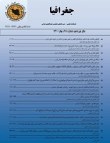Physical-Spatial Changes of Transitional Neighborhoods (The Case of District 6 of Tehran)
Neighborhoods are the vital nuclei of the city, so the dynamism of any city depends on the nature of the neighborhoods, their material and spiritual capacities, and their variability. Typically, neighborhood transformations are influenced by two categories of internal and external factors. One of the problems that neighborhoods face in most cities of the world today is the change of functions and land uses under the influence of external factors or shocks that enter them outside the neighborhoods and bring about new changes in them. The main purpose of this study is to explain the physical-spatial changes of neighborhoods in transition in the sixth metropolitan area of Tehran.
The present study is of applied type and in terms of method, has been one of the cognitive-analytical researches. The data collection method is a combination of quantitative and qualitative data and information. The most important components of quantitative data are the results of general population and housing censuses and other thematic data of the Statistics Center of Iran, as well as surveys and data collected by other relevant institutions, including the Ministry of Roads and Urban Development, Tehran Municipality and District 6, Tehran Center for Studies and Planning, Tehran Governorate. will be. In addition, the researcher's query data collection tool has been another source of empirical data from competent experts and thinkers. To analyze the data, research on the techniques of description and statistical analysis of population standard deviation, spatial mean changes, general statistics, covariance analysis, etc. to analyze the spatial distribution of the population and "Copras method and analysis of variance" to analyze the factors affecting Land use change in the area and Technis TOPSIS have been used to rank the extracted criteria.
In the present study, the physical-spatial changes of the neighborhoods in transition in the sixth metropolitan area of Tehran have been explained. Due to the importance of the location of neighborhoods in Tehran, land use changes under the influence of external factors will create new changes in them. These changes in the neighborhoods of District 6 of Tehran metropolis have been more than residential to office-commercial use. This has had a negative effect on population growth / decline, declining density, declining household size and declining sex ratio. In addition, it has now led to economic activity in the northern regions of the region. The present study is related to the physical-spatial evolution of neighborhoods in foreign studies close to the research of Edo Robert Igbenta (2009). The results of this study show that the sudden change in the use of residential land to commercial use in the city of Enogo, maximizes the desired land yield. In addition to the aforementioned researcher, the present dissertation can be close to the research of Stewart Rosenthal and Stephen Ross (2014). They have studied the economic situation of neighborhoods and cities, the economic situation at the neighborhood and city level in general, and believe that, although many spatial situations show strong economic stability, but the change in the economic situation in Neighborhood level does not necessarily mean sustainability in the urban economy, and ignoring the various necessary functions in the dynamics of urban neighborhoods and focusing solely on their economic status leads to the gradual collapse of housing, transportation infrastructure, and unplanned strengthening of population overflows.
In the framework of ecological theory and political economy, statistical models of directional or elliptical distribution of standard deviation and population mean changes, population covariance analysis, Coopers technique, study of urban land use changes in region six and TOPSIS technique have been used. The results show: 1- The population of many central areas of Tehran, especially the sixth district, has been associated with population decline during the last four decades, and this has an effect on reducing / negative population growth rate, reducing density, reducing household size and reducing sex ratio. 2- The study of the situation of the main uses of the city, District Six, has shown a decrease in the area and share of residential uses, as well as an increase in the share of commercial-office uses. 3- Analysis of the distribution and density of the population during 1996, 2006 and 2016 shows that this distribution in 1996 was relatively balanced and without strong spatial clusters, but in the last two decades the trend of population clustering has been formed during 2006 and 2016. 4- The results of TOPSIS technique findings with emphasis on physical, economic, social, demographic, environmental, managerial criteria, laws and policy-making, and communications and accesses show that one of the evaluated criteria is the extent to which economic characteristics affect land use changes from residential to commercial. With a score of (0.967), it has taken the first place.
- حق عضویت دریافتی صرف حمایت از نشریات عضو و نگهداری، تکمیل و توسعه مگیران میشود.
- پرداخت حق اشتراک و دانلود مقالات اجازه بازنشر آن در سایر رسانههای چاپی و دیجیتال را به کاربر نمیدهد.


